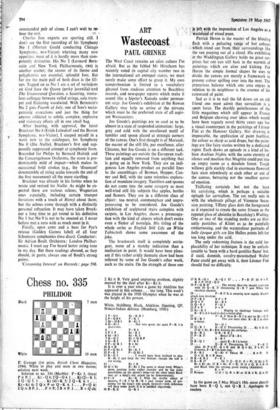PHILIDOR
Chess no. 335
F. Gamage (1st prize, British Chess Magazine, 1944). White to play and mate in two moves; solution next week.
Solution to no. 334 (Marble): P -Kt 3, threat P x P. I ... Kt - Q 4; 2 Q -Q 4. 1. .. Kt (2)- K 3; 2Q -Q 5. 1 ... Kt (4)-K 3; 2 Q-K 4. 1 ... Kt-Kt 6; 2 Q x P or Q-K 4. 1 P-Q 4; 2QxBP.1...PxP;2BxP.1...BxQ eh;
2 Kt x B. Very good unpinning problem, slightly marred by the dual after Kt - Kt 6. It is over a year since a game by Alekhine has appeared in this column ... too long. This week's was played in the 1930 Olympics when he was at the height of his powers.
White, Stahlberg. Black, Alekhine. Opening, QP, Nimzo-Indian defence. (Hamburg, 1930.)
1 P - Q 4 2 P - Q B 4 3 Kt - Q B 3 4 Q - Kt 3 preferable.
4 P - B 4 6 Kt B 3
5 P. ii. P Kt - B 3
Kt - K 5 7 B - Q 2 KtxQBP 8 Q - B 2 P - B 4 9 P-QR 3 BxKt 10 BB 0 -
11 P-x Q Kt 4 Kt -0
K 5 12 P - K 3 P - Q Kt 3 13 B - Q 3 . . . I would have been inclined to play B - Kt 2 and keep the two bishops, though the text is not wrong.
13
. . . Kt x B 14 Q x Kt B - Kt 2 The game is about level; White's pawn position looks rather sounder and be has some possibilities on the queen's wing—on the other hand Black may ge• • king's side attack (as he demonstrated).
15 0 - 0 Kt - K 2 With the double object of meeting P- B 5 by 11 - B 1 and, longer term, of pre- paring for his king's side attack; however—with deference 16 --I - K have some doubK if t it . justified objectively. B 2! Q - 1 is
Kt - K B 3 P - K 3 B - Kt 5 . . . Not very good; the quiet P - K 3 is 17 K R-Q 1 R-Q I 17 . . . P - B 5? 18 P x P. R x P; 19 Q - Q 2!
18 P - Q R 4? . . . The wrong idea—he should centralise with 18 Q - K 5! threatening Q - B 7 and White has excellent chances.
18 . . . P - B 5! It is amazing how rapidly Black's attack now develops.
19 P - R 5 BPxP 20QXP Kt - B 4 21 Q - B 3 P - Q 3 22 P x P P x P 23 Kt - K 1 . . Hoping to challenge bishops with B - B 3; it i. hard to find a better plan.
23 . . . P - K 4! Now B - B 3 is met by Kt - Q 5! 24 11 - R 7 This just loses time: R - R 2 at once is better.
Kt - Q
25 Q - K 3 R - Q 2! Threatening 26 . . . Kt x B ch; 27 Q x Kt. B - B 6! winning the exchange.
26 R - R 2 Q R-K B 2 27 P - B 3? . . Better 27 B - B I.
27 . . . R - B 5
28 B- Q 3 ... again B- B 1 is better. Q - R 4! Threatening 29 p - K 5! since 30 P x P7, Q x R and 30 Q X Kt, P x Pl; 31 Q moves, P - B 7 ch both lose.
29 B - B 1 Q - Kt 4! Threat 30 . . . R X P; 31 Q x Q. RXB mate.
30 R-K B2 P-R 3
31 K - R 17 . . Or 3! Q - Q B x P!: 32 Kt x 13, Kt x Kt eh; 33 R x Kt. R x R; 34 Q x Q. R x B cb and Black wins the ensuing .pawn ending (Alekhine).
31 . . . R x P!
32 Resigns. 32 QxQ.RXR!or32RXR,QXQ1 in the game on 5 May Black's 18th move should have been R -Q 1, not Q - R 1. Apologies to readers.


































 Previous page
Previous page